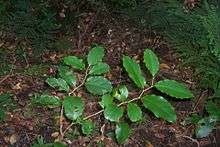Pennantia cunninghamii
| Pennantia cunninghamii | |
|---|---|
 | |
| young Pennantia cunninghamii growing near Kiama, Australia | |
| Scientific classification | |
| Kingdom: | Plantae |
| (unranked): | Angiosperms |
| (unranked): | Eudicots |
| (unranked): | Asterids |
| Order: | Apiales |
| Family: | Pennantiaceae |
| Genus: | Pennantia |
| Species: | P. cunninghamii |
| Binomial name | |
| Pennantia cunninghamii Miers | |
Pennantia cunninghamii known as the brown beech is a rainforest tree of eastern Australia. The range of natural distribution is from Clyde Mountain near Batemans Bay in southern New South Wales (35° S) to Atherton in tropical Queensland (17° S).
The habitat is tropical or sub-tropical rainforest on fertile soils, particularly growing by streams in cooler areas. However, it can occasionally be seen on poorer soils such as at Watagans National Park. Or in temperate rainforests subject to cold weather, such as at Robertson, New South Wales. Identification is simple with the leaves and branchlets, as the zig-zagging pattern is prominent. The crooked leaning trunk is also characteristic.
Description
A medium to large tree, up to 30 metres tall with a stem diameter of 90 cm. The trunk is uneven, bumpy, leaning and crooked. The base of the stem is flanged. Bark is brown or dark grey.
Leaves form on zig-zagging branchlets, the branchlets have small brown dots. Leaves alternate, elliptic or egg shaped. 7 to 15 cm long, with a short point at the tip. Leaf veins are raised on the underside and more prominent than above.
White flowers form on panicles, 5 to 12 cm long. Individual flowers about 3 mm long with five petals 2 mm long each. Flowering occurs between November and January. The fruit is a black egg shaped drupe, 13 mm long with one seed inside. Fruit matures from October to July. Removal of the fleshy aril is recommended to assist seed germination, which occurs without difficulty.
Ecology
Its fruit is eaten by the grey-headed flying fox and a variety of bird species including: brown cuckoo dove, green catbird, topknot pigeon, wompoo fruit-dove and white-headed pigeon. The larva of the moth Cardamyla carinentalis pupates between leaves of Pennantia cunninghamii.[1]
References
- Floyd, A.G., Rainforest Trees of Mainland South-eastern Australia, Inkata Press 1989, ISBN 0-909605-57-2 page 166